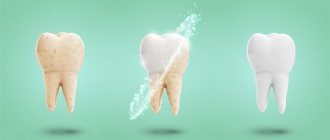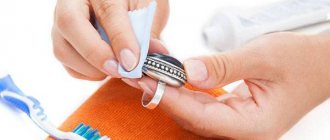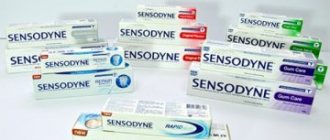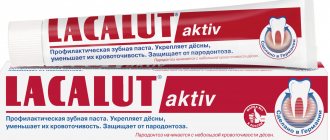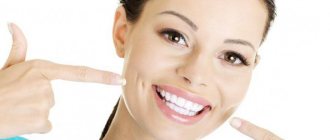The history of toothpaste dates back at least 5,000 years ago, and is associated with the culture of Ancient Egypt. Dental problems of those times were no different from modern ones - caries, unhealthy plaque, bad breath and various gum diseases. The lack of a toothbrush and paste was not a reason for a person not to take care of his oral hygiene. And, if before the invention of a special brush, clean people most often used their fingers, then our ancestors didn’t put anything in their mouths as a cleaning agent!
How did ancient people brush their teeth?
One of the first mentioned compositions, the exact recipe of which, unfortunately, has not reached our time, included such ingredients as ashes from burnt ox liver, crushed egg shells and pumice with the addition of myrrh and urea. Its authorship is attributed to the ancient Egyptians. The ancient Chinese used even more complex compositions to brush their teeth, but, unfortunately, the composition of the mixture was so sophisticated that the only component familiar to us was salt. Subsequently, various mint herbs and ginseng root appeared in the recipe.
It is known that to prevent problems with gums and teeth in Ancient Rome, it was recommended to rinse your mouth with fresh turtle blood once every few months, and they also tried to relieve toothache with it. And to eliminate the unpleasant odor, they used tree bark, goat's milk and crushed charcoal.
Mentions of other ingredients have also come down to us - crushed corals and sea shells, gypsum, sand, coal, talc, as well as ashes from the burning of the heads of mice and killed wolves, hooves, horns and joints of cattle. To give it all a pleasant smell, rose petals, mint and other pleasant-smelling substances that were not always useless for health were used.
The oldest powder found (not described) was discovered in Egypt. It is a little less than 2000 years old. It was possible to identify salt, pepper and mint in its composition.
Middle Ages
Then, in the history of toothpaste development, there was a long stagnation. There were no breakthroughs in these troubled and sad times in this direction. The Inquisition was rampant, ignorance flourished, and all kinds of superstitions were very strong. Recipes for oral care products from those centuries sounded strange, to say the least, and sometimes looked like a sentence. For example, the composition of the most popular tooth powder at that time included ground crackers, which were chewed on by a mouse. In Europe, the situation was even worse than the “global average.” Complete unsanitary conditions reigned here, slops poured out right next to the house, washing clothes was extremely rare, and baths were taken only on major holidays, and even then not always. Probably many Europeans of the Middle Ages did not brush their teeth even once in their lives. The only items in use were toothpicks, and special “cleanies” used mouth rinsing after a meal.
Types of toothpastes and their purposes
The range includes products for the prevention of caries, against bleeding gums, for whitening enamel and restoring the pH balance of the oral cavity - this is just a part of the possible uses. The main types are discussed below, based on their “functionality”.
Hygienic for prevention
The main purpose is to keep teeth and oral mucosa clean. They remove plaque well and freshen breath. This also includes children's ones, which act gently and usually have a pleasant taste. This is the best option for daily use if there are no obvious problems with teeth and gums.
Bleaching agents with abrasive particles
The action of whitening pastes is aimed at lightening the enamel using chemical reagents or large abrasive particles. In the first case, bleaching is the result of a chemical reaction of special enzymes, for example, pyrophosphates - they literally destroy bacterial plaque and remove pigmented spots. Abrasive particles make it possible to achieve lightening of the enamel through mechanical action. Here the RDA indicator usually exceeds 80, so they can only be used in courses, not on an ongoing basis. Otherwise, your teeth may become too sensitive.
There is a large selection of abrasive toothpastes
Gum for gentle care
They are characterized by a low content of abrasive particles - no more than 60. Suitable for people with sensitive teeth and damaged enamel. This usually includes mineral components that accumulate in the enamel and contribute to its restoration. An excellent option for cases of hyperesthesia, but only until the condition normalizes. Then you can move on to preventive measures - on the recommendation of the dentist. The fact is that dentures do not do a very good job of cleaning plaque and softening hardening deposits.
“Oh, for me, going to the dentist is almost tantamount to psychological hard labor! The result is half your mouth covered in fillings and increased sensitivity. At the last medical examination, the dentist recommended changing the toothpaste. He says it's too hard for my teeth and gums. I switched to another, gentle one. Within a couple of months, sensitivity was restored and the gums stopped bleeding. It often happens that we ourselves only make things worse, so consultation with a doctor will never be superfluous.”
Rita1985, from correspondence on the forum www.32top.ru
With anti-caries effect
When fluoride and/or calcium are added to the composition, it acquires an anti-caries effect. These components help strengthen dental tissues and prevent caries. Periodic use of such products ensures surface remineralization and increases the resistance of the enamel to the negative effects of external factors. But you shouldn’t use them on an ongoing basis - it may have the opposite effect. If the content of these substances is high, you should first consult a dentist.
Strengthening pastes may contain calcium
Anti-inflammatory action
To restore and strengthen gums, herbal ingredients are usually added. The composition also contains active substances with an antibacterial effect: the antibiotic triclosan, the antiseptic chlorhexidine and others.
The main goal is the destruction of pathogenic microflora, the removal of inflammatory processes and the restoration of soft tissues. Such pastes are usually prescribed as part of maintenance therapy in the treatment of gingivitis and periodontitis. They help in the fight against bleeding and swelling. If potent components are present in high concentrations, use can only be started after the doctor’s approval, and the course itself should last no more than three weeks in a row.
Saline against sore gums
The active components have a positive effect on the condition of the mucous membrane. Salts in high concentrations effectively reduce inflammation by ensuring the outflow of excess fluid from soft tissues, and soothe acute symptoms: pain, swelling, bleeding. Recommended for gingivitis, periodontitis and periodontal disease. Active components improve blood flow and stimulate metabolic processes. The only downside is that it has a specific taste.
Organic with natural ingredients
Products based on plant components do not contain harsh chemicals and provide gentle cleansing. Essential oils and extracts of medicinal plants must be supplemented with surfactants (surfactants) - without them, high-quality cleansing is impossible. It’s another matter if the surfactants themselves are of a plant nature, and then we can confidently call the product completely natural. This is a good choice for children, as well as adults with healthy teeth and gums. However, according to some reviews, the effectiveness of organic products is far from desired. They are not cheap and often cost a lot.
These plant-based products do not contain chemicals.
Oral hygiene products in the 8th-19th centuries
The good work of developing and improving toothpaste began only at the end of the 8th century, although its beginning was not entirely successful. The products of that time could hardly bring anything other than direct harm to the teeth, although in appearance and consistency they already had some similarities with modern analogues.
For their production, ingredients such as broken brick, crushed porcelain and clay were used, and soap was added to bind it all into a kind of paste. It is quite expected that such funds did not find a large number of admirers.
The first good quality toothpaste appeared only in the middle of the 19th century. The basis for it was starch and glycerin, which contained chalk paste in a jelly-like state. And yet, powder remained the main hygiene product for teeth. They packed it in paper bags, which was extremely inconvenient during water procedures.
First pasta
The year 1873 can be considered a turning point in the history of toothpaste. A certain pharmacist from New York named Colgate decided to eliminate the paper version of packaging and sell tooth powder liquefied in glass jars. In fact, the idea turned out to be so-so, since scooping this jelly-like mass from a jar onto a brush was even more inconvenient, unhygienic and impractical than pouring powder from a bag. However, thanks to the entrepreneurial spirit of this pharmacist, his name is very familiar to modern people. About how he managed this - a little further.
Selection criteria - what to look for
To choose the ideal product for yourself, it is important to take into account many factors at once: the condition of the enamel, the presence of carious processes and tartar, the condition of the gums, age and much more. When you have a clear idea of the current state of the oral cavity, you can move on to specific selection criteria.
Type of pasta
As mentioned above, you need to choose a product based on individual needs and indications. If there are no problems with your teeth and gums, a prophylactic paste would be the best option. If there are problems with the enamel or the condition of the mucous membrane, it is worth considering treatment and preventive options. But in this case, you must first consult a dentist.
You need to choose a product based on individual needs and indications.
Ingredients
Be sure to read the ingredients carefully before purchasing. If there are allergy sufferers in the family, it is important to make sure that there are no components that can provoke allergic reactions. It is advisable to choose products with a minimum concentration of preservatives and foaming agents. Fluoride is often added for an anti-caries effect, but this same component can have the opposite effect if teeth are in contact with it for a long time. It is recommended to use according to indications.
On a note! On the question of how to choose a product based on the stripes on the tube: forget that these designations have anything to do with the composition. In fact, these are just marks for packaging machines that are needed only at the production stage. The color is related to the characteristics of the equipment used and does not indicate anything about the safety of the product.
Baking soda removes plaque well and helps soften hardened deposits. But due to its high degree of abrasiveness, it can easily damage the enamel and lead to its thinning. Therefore, it is advisable to use such products in courses and according to indications. Some compositions are as close as possible to natural ones, but these usually cope worse with their main task, do not foam well and are more expensive. Keep in mind that the concentration of parabens (preservatives) should not exceed 2%, and the surfactant content should be within 1-3%.
Degree of abrasiveness
The presence of abrasive particles ensures high-quality mechanical cleaning of plaque and allows you to return your teeth to their natural whiteness. On the other hand, too long exposure of this kind leads to injury to the enamel, its thinning and hyperesthesia. The abrasiveness indicator is indicated by the RDA marking. If it is a whitening paste, then this indicator can reach 100 units. Conventional preventive – up to 80 maximum, gentle (dental) – no more than 601.
Taste and smell
As for taste and smell, these criteria are left to the discretion of the user. Sometimes a too strong taste can cause unpleasant sensations or even gag reflexes - this also needs to be taken into account.
Taste and color are also criteria for choosing a product
First tube
Surprisingly, the dental tube knows exactly its birthday - May 22. It was on this day in 1892 that it was invented by the American dentist Washington Sheffield. More precisely, he did not come up with the tube itself, but the idea of using it.
While thinking about how to conveniently package a hygienic product, the doctor remembered or learned for the first time about a certain artist who, half a century ago, stored his paints in tin tubes to protect them from drying out. After thinking a little about modernizing the packaging, the dentist made an almost modern tube for dental cream, i.e. became the one who invented both toothpaste and modern packaging for it. But who created a thriving industry on it is another question.
Teeth cleaning.
DISCOVERY OF LEVENHOEK.
Brushing teeth with salt is Leeuwenhoek's invention: Anthony van Leeuwenhoek is a Dutch naturalist, microscope designer, founder of scientific microscopy, member of the Royal Society of London. In 1674, the Dutch inventor Anthony van Leeuwenhoek made two outstanding discoveries simultaneously. He discovered the world of microbes and a way to destroy this very world in his own mouth with the help of salt. One day, under the lens of the microscope he invented, there was a wash from his own teeth, teeming with small creatures. Having wiped his teeth with a cloth with salt, he did not find any microbes on the new wash. After that, he vowed to himself to practice brushing his teeth with salt for the rest of his life. And Levenguk lived for 93 years.
Missed opportunity
A New York dentist managed to invent both toothpaste and a tube for it, but didn’t think of patenting it! And, as you know, if the inventor forgets to do this, others do it for him. This is where the cunning pharmacist Colgate appears on the scene again, who understands how promising the idea is and runs to the patent office, where he patents the invention as his own. Having changed only tin to aluminum, his company begins to package many of its products in tubes - creams, soaps, shampoos, etc. But in fact, we are still using the idea of a dentist who is not very enterprising.
Results
Ancient people have been thinking about oral hygiene since ancient times. At first they used dust, sand, and chalk for cleaning, but quite quickly they figured out adding additional elements to the main composition for smell and taste.
The Slavs used birch charcoal, and later oak bark, to keep their breath fresh and clean their teeth. Ancient Persians or ancient Indians used improvised means to clean their teeth. The Persians noticed that too aggressive abrasive substances damage tooth enamel and scratch it.
A real breakthrough was achieved only in the 18th century. Then they began to produce tooth powder for mass consumption. After the invention of the tube, toothpaste became an essential element of hygiene and the number one product when creating a cosmetic bag for personal care.
Today on the market the paste is sold in plastic tubes. This is a relatively modern invention, to which there is still no alternative. The product is squeezed out of the tube by simply pressing on the body of the tube. In addition, this scheme makes it possible to use the product economically. And the screw-on lid helps preserve the properties of the paste for a long time.
When did toothpaste appear in Russia?
Progress came to Russia much later. From time immemorial, birch charcoal was used to clean teeth in Rus', and mint was used to freshen breath. For the winter it was specially dried for this purpose. By the way, they acted very far-sightedly, because, in addition to a pleasant aroma, mint also has antibacterial properties. In more northern regions and in Siberia, mint was replaced by needles of coniferous trees - cedar, larch, fir. In some areas, cedar or pine resin was preferred. In addition, in Rus', people have always chewed zabrus (a wax cap containing honey cut from a honeycomb).
Everything changed, like many things in our country, with the coming to power of Peter I, who gave an order to brush your teeth with chalk, in the European way. It was applied to the enamel and then rubbed with a piece of cloth. And this continued for more than a century.
They gradually began to add soap and tree resin to the chalk powder, and then borax. At the turn of the 20th century, taste-improving glycerin appeared on the ingredient list. There was no single recipe, each pharmacist was “his own director” and charged a lot for the author’s work, so only wealthy people could afford this product, and brushes specially designed for cleaning.
The paste appeared in Russia 30 years later than its invention, and the Soviet product, packaged in a tube, was half a century late, seeing the light only in 1950 (and almost immediately fell into the category of scarce goods), and even then thanks to the space industry. Active developments were underway in this direction, and brushing teeth in a state of weightlessness with powder was inconvenient not only physically, but also in front of the entire world community. The first paste was called “Pearl” and it was produced specifically for future cosmonauts, as were special tubes of food.
Interesting facts about toothpaste
- The fact that constant use of whitening paste makes a smile snow-white is a misconception and even a direct deception of manufacturers. It only removes plaque, but with frequent use it damages the enamel and makes the tooth more sensitive and susceptible to caries. The thinnest layer of fluorine is not enough to protect against it.
- The first Chinese toothbrush consisted of hog bristles inserted into a split bamboo stick. The device is not only inconvenient, but for some reason it is also very expensive, although there were plenty of pigs and bamboo in China at that time. Only wealthy citizens bought them, while the rest had to be content with a free finger.
The most expensive paste in the world, priced at 50 thousand euros per tube, cannot be bought even by the richest people, because it is intended for one single person - the Queen of England. Its fabulous price is supposedly justified by its completely unique composition, which Elier Cosmetics, its developer, of course, keeps secret.
- Among mint, strawberry, banana and other flavors, there are pastes with completely original aromas and tastes - bacon, cucumber, chocolate and even scotch and bourbon.
- The Doramund product, produced several decades ago, is recognized as the most harmful product in the history of mankind. It was radioactive, but people still knew little about the terrible consequences radioactive substances cause. There are no statistics on the number of victims.
- For those who wanted to disassemble the tube of tri-color paste and see why they do not mix, but did not, we inform you that inside there are three chambers, the contents of which are found only at the neck.
Modern products often repeat the composition of ancient analogues. The only difference is that the current ingredients are obtained in laboratory conditions.
- The paste holds its shape due to the sticky and slimy seaweed. Without them, it would simply flow off the brush.
History of toothpaste: from 5000 BC e. to the present day
Ksenia Kotova editor of Dental Magazine
In the previous article we talked about the appearance of the first toothbrushes and their creators. As we continue our conversation about the history of oral hygiene, we will take a fascinating journey through time.
Did you know that oral hygiene was a top priority in society as far back as 5000 BC?
The oldest toothpaste formula in the world belongs to the Egyptians. They ground rock salt, mint, dried iris flowers, pepper and mixed them together to create a cleaning powder.
Rice. 1. Teeth brushing procedure. Ancient Egypt.
Research shows that the ancient Egyptians first developed dental cream back in 3000–5000 BC. BC e. It consisted of powdered ox hoof ashes, myrrh, crushed eggshells, pumice, and water (real “toothpaste” was likely powdered at first, with water likely added during the cleaning process). And although the cream had an unpleasant taste, it still provided a minimal level of cleaning to the teeth and helped fight harmful plaque.
Later in Greece and Rome, more abrasives were added to the powder mixture: crushed bones and oyster shells, chalk, salt, ash and plant roots. They cleaned teeth well of plaque and harmful bacteria. It is known that the Romans added various flavorings to the mixture to make the paste more palatable. And they could cope with bad breath easily and quickly - by sweetening their breath with honey. Powdered charcoal and bark were often flavored, but their taste left much to be desired.
Around the same time, tooth powder was also being prepared in China and India. Caring about the taste of the mixture, the Chinese preferred to use natural ingredients as flavorings, such as ginseng, mint, crushed lotus flowers, and cocoa grains.
However, ancient methods of brushing teeth were not available to everyone. If you were rich, you could easily afford chewing sticks, tooth powder and other aromatic dental hygiene products made from mastic tree bark extract or scented resin. But if you happened to be born into a poor family, your teeth would probably not receive proper care and would simply be removed with pliers.
Rice. 2. An ancient toothpaste recipe written in a manuscript.
More than one century passed before toothpaste acquired the appearance we are familiar with today. Before 1850, toothpaste was powder.
Today, many people use baking soda to brush their teeth. This is a practice that is hundreds of years old. Back in the 1800s, tooth powders were a common way to clean teeth. However, these powders were not as safe as baking soda.
At the end of the 18th century, tooth powder became known in Great Britain, close in composition and properties to modern ones.
The most popular Victorian toothpastes were cherry toothpaste and betel paste. But these pastes did not taste like cherry or betel. They received this name because of the red color obtained due to the addition of carmine. Color variations from bright red to pale pink were used as an advertising ploy - so the pastes could be given a romantic name like “Damask Rose”, “Carnation”, “Coral”. The paste without red pigment was called “White Cherry”.
Rice. 3. Jars of cherry toothpaste.
In 1820, a dentist named Dr. Peabody added soap to toothpaste, apparently to boost the cleanliness factor. Unsurprisingly, no one liked the taste of the soap and it was later replaced with sodium sulfate to make the paste smoother.
During this period, tooth powders begin to be made from chalk mixed with crushed herbs and flower fruits. Soap was included in toothpaste until 1945.
It wasn't until World War II that brushing teeth became commonplace. Soldiers were required to brush their teeth daily, and this soon became the norm.
In 1850, the American company Colgate-Palmolive introduced the world's first toothpaste in a jar, and in 1873 began mass production of this product. Colgate introduced its toothpaste in a tube similar to modern toothpaste tubes in the 1890s. The idea of putting toothpaste in a tube came from dentist Dr. Washington Sheffield.
Fig.4. Colgate office and store, New York.
Fluoride toothpastes to prevent tooth decay were introduced in 1914, and in the second half of the 20th century, toothpastes created to prevent or treat certain diseases and conditions, such as tooth sensitivity, appeared.
The latest advances in hygiene products include whitening toothpastes and toothpastes containing triclosan, which provide additional protection against plaque and tartar, gum disease and bad breath.
Toothpaste is a wonderful invention. And now, the next time you reach for a tube, you will certainly remember its rich history.
Non-traditional uses
It is logical to assume that something that can clean tooth enamel can also clean something else quite well. With this in mind, resourceful people have found many unconventional uses for this oral hygiene product.
- The paste perfectly cleans silver, cupronickel, and other metals and even removes stains from carpets and clothes. Many people use it to update their shoes. This works especially well with light-colored sneakers.
- A drop of the product will relieve itching from an insect bite, pain from a burn or scratch.
- Using it to polish your nails makes them strong and shiny.
- Gel analogs are successfully used by girls as a hair styling product.
- Rubbing kitchen utensils, baby bottles, or hands with toothpaste can help rid them of unpleasant odors.
- It perfectly cleans computer disks, as well as keyboards that have become dirty by hand.
- If you wipe the glass glasses with paste and then wipe them dry with a soft cloth, they will not sweat in winter in a warm room, and swimming goggles and masks will not sweat from the inside under water.
- Expensive facial products for acne can be replaced with regular toothpaste - the skin becomes cleaner, whiter, and acne scars disappear much faster thanks to the inclusion of the preservative formaldehyde in their composition.
5 / 5 ( 1 voice )

